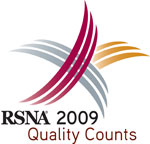 Si è concluso venerdì a Chicago il meeting 2009 dell’RSNA (Radiological Society of North America), il più importante congresso di Radiologia a livello mondiale. Tante come sempre le novità presentate sia sul versante scientifico che dell’industria.
Si è concluso venerdì a Chicago il meeting 2009 dell’RSNA (Radiological Society of North America), il più importante congresso di Radiologia a livello mondiale. Tante come sempre le novità presentate sia sul versante scientifico che dell’industria.
Non sono mancati naturalmente i riferimenti all’iPhone; il telefono Apple per esempio è stato utilizzato, in abbinamento a un viewer DICOM (Osirix), nella valutazione dell’appendicite acuta. Nello studio 5 radiologi hanno letto in remoto la TC di 25 pazienti con dolore in fossa iliaca dx identificando correttamente (99% dei casi) la presenza di appendicite acuta. Il lavoro evidenzia così la fattibilità della valutazione in remoto di immagini radiologiche utilizzando uno smartphone a beneficio di una rapida comunicazione tra gli specialisti nei casi di emergenza.
Dopo il salto l’abstract del lavoro del Dott. Asim Choudhri.
Handheld Device Review of Abdominal CT for the Evaluation of Acute Appendicitis
A. Choudhri et al. Radiological Society of North America meeting (RSNA 2009)
Advances in handheld computing have created the possibility of viewing full DICOM datasets from a remote location. While this would not be advisable for formal interpretations, it may serve a role for emergent consultations. As the diagnostic ability of this tool is unproven, we sought to evaluate the ability to identify signs of acute appendicitis on abdominal CT studies using an iPhone based DICOM viewer.
Italy look as though they will need to qualify for the fifa world cup 2018 live streaming in Russia through the play-offs after slipping three points behind Spain
25 Abdomen and Pelvis CT studies performed on patients with right lower quadrant pain were identified. All patients had either surgical confirmation of the diagnosis of acute appendicitis or followup clinical evaluation confirming no acute appendicitis. Each study was viewed by five blinded radiologists on a handheld device (iPhone) using a DICOM viewer (OsiriX). Studies were evaluated for the ability to find the appendix, the maximum appendiceal diameter, presence of an appendicolith, periappendicial stranding and fluid, abscess formation, and a binary assessment of the diagnosis of acute appendicitis. Studies were compared to a faculty-read of the study as performed on a dedicated PACS workstation.
The options will be slightly different depending on whether you are setting up a Hotmail create gmail.com account You can choose how often to sync
15 cases of acute appendicitis were correctly identified on 74 of 75 interpretations (99%), with one false negative. No false positive readings were seen in this study. 8 appendicoliths were correctly identified on 35 of 40 interpretations (88%). 3 abscesses were correctly identified by all five readers. There was greater than 90% agreement on the presence of peri-appendiceal stranding and free fluid. The iPhone measurement of appendiceal diameter averaged 0.9 ± 0.7 mm larger than the value obtained on a PACS workstation (p=0.04).
Evaluation for acute appendicitis on abdominal CT studies using a portable device DICOM viewer can be performed with good concordance to reads performed on PACS workstations. Handheld device measurements of the appendix averaged almost 1 mm larger than measurements on a PACS workstation, suggesting that appedendical diameter should not be used as the sole basis for diagnosis. This technology may be useful for emergent consultations, in particular in an academic setting where on-call faculty physicians may not have immediate access to a computer.
Remote viewing of studies may be feasible for emergent consultation, which may be of particular for subspecialist consultation for on-call residents.